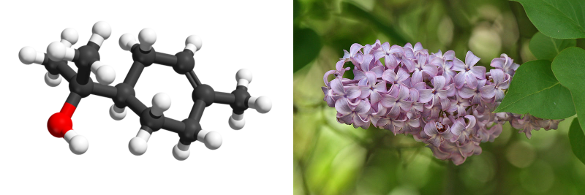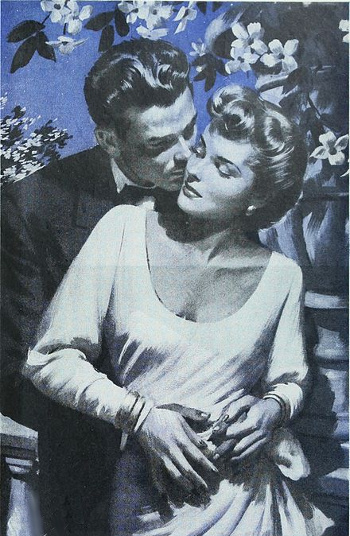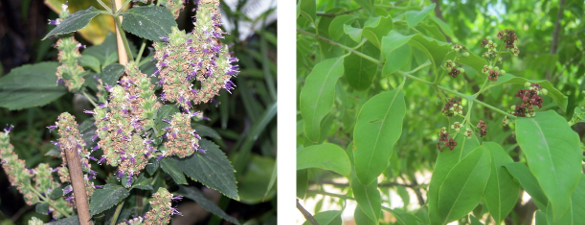Synthetic Fragrances
September 3, 2018
A
chemical laboratory will have a background
fragrance that identifies what work is done in it. For
safety reasons, such laboratories are well
ventilated, but the
human nose is capable of detecting minute quantities of substances in the air. It's easy to identify an
inorganic chemistry laboratory, principally because of the
sulfur and
nitrate odors. An
organic chemistry laboratory is very easy to identify, since
organic compounds have an "organic" fragrance, and they have a high
volatility.
For a period of several months, my laboratory had the pleasant
scent of
lilac. I was doing a novel
electroplating, not from an
aqueous solution, but from an
alcohol. Although I was getting some encouraging results, my process needed some optimization, so I decided to try different
mixtures of alcohols. The alcohol,
α-terpineol, has a pleasant lilac fragrance, so it's a common additive to
soaps and
perfumes. It's also an alcohol with a much higher
molecular weight (154.25
grams/
mol) than that of the simple alcohols,
methanol (32.04) and
ethanol (46.07), so it was a good modifier for my electroplating bath.

There's definitely a resemblance. Α-terpineol and a lilac flower. Lilac is an Asterid Eudicot Angiosperm of the Order Lamiales, Family Oleaceae, and Genus Syringa. Olive, jasmine, and forsythia are also members of the Oleaceae Family. Left image, an α-terpineol ball-and-stick model (Carbon=black, Oxygen=red, and hydrogen=white) by Ben Mills and Jynto; right image, lilac flowers and leaves, by Jjron. Both images via Wikimedia Commons. (Click for larger image.)
As I wrote in an
earlier article (Smell, October 23, 2013), our
sense of
smell is more properly termed
olfaction, and it's one of the five traditional senses of man. The others are
taste,
sight,
hearing and
touch. Man's sensitivity to sexual
pheromones is much less than that of many
animals, but pheromones do
affect our mate choice. We try to
game the system through use of
perfumes. The 2016
fragrance materials market was estimated to have been nearly fifty billion dollars.

The way to a man's heart is through his nose?
Most men will admit that the scent of a certain perfume will bring back memories of a girlfriend. Marcel Proust's "À la recherche du temps perdu" ("Remembrance of Things Past") contains a scene, known as the "episode of the madeleine," in which the taste of a cake triggers a childhood memory.
(Portion of an advertisement for Evening in Paris perfume that appeared in an 1889 issue of Ladies' Home Journal, via Wikimedia Commons, but sourced from the Internet Archive.)
Can there be too much of a good thing? The 1980s saw the rise of "monster-scented" perfumes whose
provenance can be traced to
Chanel No. 5. These fragrances are called monsters, since you smell them not just on the woman, but everywhere she's been in the last few hours. There are
anecdotes about
gas chromatographs in chemical laboratories giving extra
peaks when certain female
technicians were in the area. In that
decade, I could always tell when a certain female chemist was in the building. Fortunately, the scent of her monster perfume was quite
pleasant.
The monsters of the 1980s were
Yves Saint Laurent's Opium and
Poison by
Christian Dior. Even their names invoke their monster status. The scent trail left by these monsters is termed
sillage, which is the
French word for the
water wake left by a passing
ship. The ship might have vanished over the
horizon, but its wake is still visible. Note the similarity of the word,
tillage, the making of
furrows in
soil for
planting, to sillage, the
analogous furrowing of the
sea.
The most abundant natural fragrances are
floral. Interestingly, while
prehistoric man used
flowers in
burials,[1] there is no evidence that our prehistoric
ancestors adorned themselves with flowers. However, in
historical times, floral perfumery was well established, reaching a culmination with the 1927 introduction of
Arpège, a perfume that contains about 60 floral components. The
ancient Greeks had developed a
perfume industry at least as far back as the
4th century BC.
Theophrastus (c. 371 - c. 287 BC) described the perfumer's art in a short
treatise on
odors, not surprisingly entitled,
On Odors. This is usually placed as an
appendix to his
Enquiry into Plants (Περι φυτων ιστορια, Historia Plantarum).[2-3]
On Odors discusses the
oil extraction of
fragrant compounds.
"Now the composition and preparation of perfumes aim entirely, one may say, at making the odours last. That is why men make oil the vehicle of them, since it keeps a very long time and also is most convenient for use. By nature indeed oil is not at all well suited to take in an odour, because of its close and greasy character: and of particular oils this is specially true of the most viscous, such as almond-oil, while sesame-oil and olive-oil are the least receptive of all." [2]
Nature provides us with a multitude of fragrance sources, as listed on the
Wikipedia Perfume Page. Along with flowers, there are the
fruits,
leaves, and
twigs of plants; plant
resins, of which
frankincense and
myrrh are examples;
bulbs and
roots, such as
ginger;
seeds such as
coriander,
anise, and
nutmeg;
tree bark, such as
sandalwood,
cedar, and
pine;
animal musk, and the
cetacean secretion,
ambergris.

Pogostemon cablin and santalum album plants, the sources of the patchouli and sandalwood fragrances. Patchouli has a strong scent, and it's been used in perfumes for centuries. Sandlewood was a common fragrance for incense in the youth culture of the 1960s and 1970s. The verse, "she comes in incense and patchouli...," was part of the The 1976 song, Year of the Cat, by Al Stewart. (left image, a pogostemon cablin plant at the Old Botanical Garden of Göttingen University, and right image, a santalum album plant by Krish Dulal, both from Wikimedia Commons.)
While
steeping roses and other natural materials in a pot of
solvent was the sole method of perfume
manufacture in
antiquity, most of today's fragrances are produced
synthetically. Fragrance chemists start with a
chemical analysis of natural fragrances as an aid in producing the same
chemical compounds or some
functional analogs. The
International Fragrance Association lists 3,999 chemicals used by its members in 2015.[4]
As I wrote in an
earlier article (Terpene, May 15, 2017), most natural odorants are a class of chemicals called
terpenes. There are thousands of terpenes to be found in natural and synthetic fragrances, with the smaller terpene
molecules being more strongly fragrant. The higher
molecular weight terpenes have lower
volatility, and this makes their scents more tenacious.
The five principal fragrance terpenes are
geraniol-
nerol,
linalool,
citronellol,
citronellal and
citral. These, and derived compounds such as their
esters and
alcohols, are widely used. They are used, also, as
reagents for synthesis of other terpenes. The following table lists some important terpene-derived chemicals.[5]
Wikipedia's Aroma Compound Page lists many more fragrance chemicals.
Fragrance
categories are an arbitrary construct, and each person will interpret a fragrance in relation to his past experience. That's why an
Internet search will yield many different lists of fragrance categories. I've compiled my list of eight categories into the chart shown below. In my choice of eight, I've followed in the
tradition of the
Eightfold Way organization of
hadrons that led to the development of the
quark model.

My synthesis of the "eightfold way of fragrance."
The categories are Floral, Fruity, Citrus, Vegetable/Green, Woody, Spicy, Oriental, and Fresh/Oceanic.
Decades ago, my wife has a bottle of the floral fragrance, Lancome Trésor. Yves Saint Laurent Opium, mentioned above, would go into the oriental category. Britney Spears Believe is a woody scent. Sea-breeze scented Calone, also known as the "watermelon ketone," is a member of the fresh/oceanic category.
(Created using Inkscape. Click for larger image.)
Catherine Maxwell, professor of
Victorian literature at
Queen Mary University of London, has written an enlightening and entertaining article about synthetic fragrances in a recent issue of
Aeon Magazine.[6] While the natural is preferred over the artificial in things such as
gemstones,
Victorian culture preferred synthetic fragrances to natural fragrances.
Of course,
cost is one factor in this. Such sources of natural fragrances as
jasmine are relatively rare, they are expensive to
cultivate, and their fragrance is hard to extract. More importantly, the quality of natural materials is affected by soil quality and the
weather, while synthetics are uniform from batch to batch. Modern perfumes might use natural substances, but they're augmented with about 80% synthetics since those chemicals give them qualities beyond those of the natural materials.[6] In fact,
hydroxycitronellal, a synthetic lily-of-the-valley fragrance developed in 1905, is a better lily-of-the-valley fragrance than the flower.[6]
Maxwell also presents the history of synthetic musk.[6] The original source of musk is an
abdominal gland of the
male musk deer, and it's obtained by killing the animal. While natural musk was always difficult to obtain, the musk deer became an
endangered and protected species in 1979. Albert Baur found a synthetic alternative to musk in 1888; interestingly, his "nitro-musk" was a
derivative of
TNT that he found while doing research on
explosives.[6]
Baur subsequently developed
other nitro-musks, such as musk ketone and musk ambrette. The later was a component of Chanel No 5.
Patents on synthetic musk made a fortune for Baur, but his synthetics have been replaced in recent times by safer and more stable synthetics.[6] Patented synthetics are still a source of income for many fragrance companies, which might patent three or four synthetics in a year.[6]
References:
- Brian F. Byrd and Christopher M. Monahan, "Death, Mortuary Ritual, and Natufian Social Structure," Journal of Anthropological Archaeology. vol. 14, no. 3 (September, 1995), pp. 251-287, https://doi.org/10.1006/jaar.1995.1014.
- Theophrastus, "De odoribus (Concerning Odours)," vol. II of the Loeb Classical Library edition of the Enquiry into Plants, 1926, via the University of Chicago.
- Theophrastus, "Enquiry into plants and minor works on odours and weather signs," Greek with an English translation by Sir Arthur Hort, vol. 2, W. Heinemann (London, 1916), pp. 524.
- IFRA Volume of Use Survey 2016: Transparency List, The International Fragrance Association (PDF file).
- D.H. Pybus, and C.S. Sell, "The Chemistry of Fragrances," Chapter 4, Royal Society of Chemistry, December 31, 1999, pp. 276, ISBN-13: 978-0854045280 (via Amazon).
- Catherine Maxwell, "Sweet artifice," Aeon Magazine, July 18, 2018.
Linked Keywords: Chemistry; chemical; laboratory; odor; fragrance; safety; ventilation (architecture); ventilated; human nose; inorganic compound; inorganic chemistry; sulfur; nitrate; organic chemistry; organic compound; volatility (chemistry); scent; syringa vulgaris; lilac; electroplating; aqueous solution; alcohol; mixture; α-terpineol; soap; perfume; molecular mass; molecular weight; gram; mol; methanol; ethanol; Asterid; Eudicot; Angiosperm; Lamiales; Oleaceae; Syringa; Olive; jasmine; forsythia; Ben Mills; Jynto; Jjron; Wikimedia Commons; sense; smell; olfaction; taste; sight; hearing; touch; pheromone; animal; human body odor; gaming the system">game the system; perfume; fragrance oil; fragrance material; market; proverbial phrase; the way to a man's heart; perfume; long-term memory; girlfriend; Marcel Proust; À la recherche du temps perdu; madeleine cake; advertising; advertisement; Ladies' Home Journal; Internet Archive; provenance; Chanel No. 5; anecdotal evidence; anecdote; gas chromatography; gas chromatograph; amplitude peak; technician; decade; pleasure; pleasant; Yves Saint Laurent; Opium; Poison; Christian Dior; sillage; French language; French word; water wake; ship; horizon; tillage; plough; furrow; soil; sowing; planting; analogy; analogous; ocean; sea; flower; floral; primitive culture; prehistoric man; burial; ancestor; history; historical; Arpège; ancient Greece; ancient Greeks; perfume; industry; 4th century BC; Theophrastus (c. 371 - c. 287 BC); treatise; odor; addendum; appendix; Historia Plantarum; Enquiry into Plants; oil; extraction (chemistry); aroma compound; fragrant compound; vehicle; grease; viscosity; viscous; almond-oil; sesame-oil; olive-oil; Nature; Wikipedia Perfume Page; fruit; leaf; twig; resin; frankincense; myrrh; bulb; root; ginger; seed; coriander; anise; nutmeg; tree bark; sandalwood; cedrus; cedar; pine; animal musk; cetacea; cetacean; secretion; ambergris; patchouli; pogostemon cablin; santalum album; century; centuries; incense; youth culture; 1960s; 1970s; Year of the Cat; Al Stewart; Old Botanical Garden of Göttingen University; Krish Dulal; steeping; rose; solvent; manufacturing; manufacture; ancient history; antiquity; chemical synthesis; synthetic; analytical chemistry; chemical analysis; chemical compound; functional analog; International Fragrance Association<; terpene; molecule; molecular mass; molecular weight; volatility (chemistry); geraniol; nerol; linalool; citronellol; citronellal; citral; ester; alcohol; reagent; Wikipedia's Aroma Compound Page; wood; dihydromyrcenol; citrus; hydroxycitronellal; (Methyl)ionone; violet plant; linalyl acetate; lavender; borneol; isoborneol; acetate; pine; syringa vulgaris; lilac; ambergris; carvone; spearmint; menthol; mentha; mint; acetylated; cedarwood; cedar; categorization; category; web search engine; Internet search; tradition; Eightfold Way (physics); hadron; quark model; vegetation; green; woody; spicy; oriental; fresh; Oceanic; wife; Lancome; Trésor; Britney Spears; calone; watermelon; ketone; Inkscape; Catherine Maxwell; Victorian literature; Queen Mary University of London; Aeon Magazine; gemstone; Victorian era; Victorian culture; cost; jasmine; horticulture; cultivate; weather; hydroxycitronellal; abdomen; abdominal; gland; male; musk deer; endangered and protected species; derivative (chemistry); TNT; explosive material; synthetic musk; nitro-musk; patents.